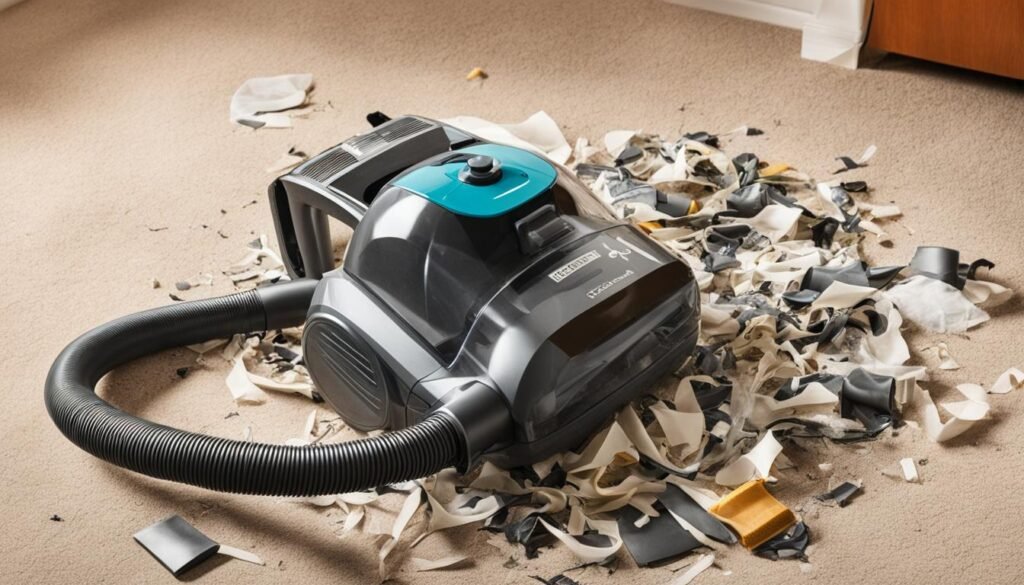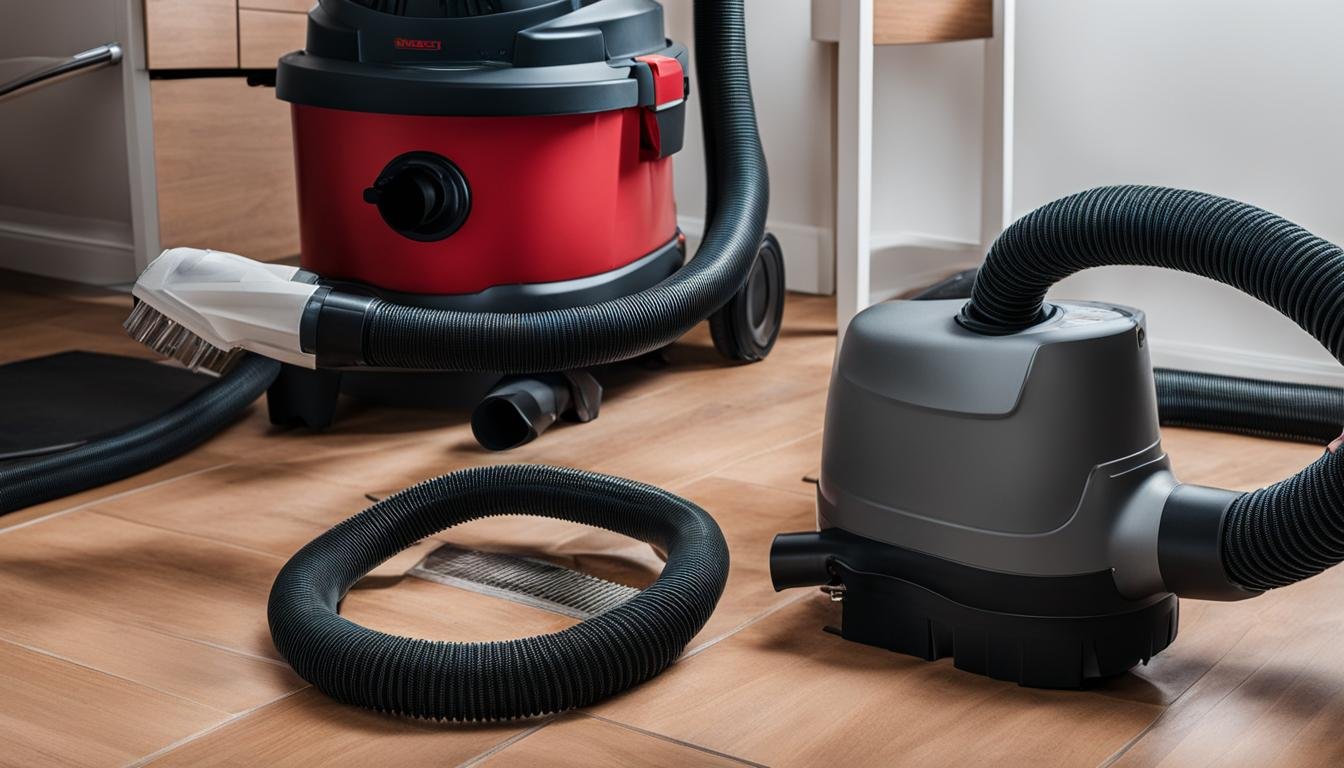Losing suction power in your vacuum cleaner can be frustrating and hinder your cleaning efforts. When faced with a vacuum cleaner not sucking, it’s important to identify and address the underlying causes. Several common issues can lead to reduced suction, including incorrect height settings, full collection canisters or vacuum bags, clogged filters, blocked hoses, and tangled rollers.
One possible reason for a vacuum cleaner not sucking is an incorrect height setting. If the vacuum is set too low or too high for the type of floor you are cleaning, it can result in poor suction. Another common cause is a full collection canister or vacuum bag. When these are full, airflow is restricted, reducing the vacuum’s suction power.
Clogged filters can also contribute to suction loss. Over time, filters can accumulate dirt and debris, inhibiting proper air circulation. Additionally, blocked hoses and tangled rollers can impede the vacuum cleaner’s performance. When hoses are clogged or rollers are tangled with hair and other debris, airflow is restricted, leading to low suction.
Key Takeaways:
- Incorrect height settings on your vacuum cleaner can result in reduced suction power.
- Regularly check and empty the collection canister or replace the vacuum bag to maintain optimal suction.
- Clogged filters can restrict airflow and decrease suction performance.
- Clear any blockages in the hoses and remove tangled debris from the rollers to improve suction.
- If the above steps don’t restore suction, consider seeking professional assistance or contacting a vacuum repair shop.
Troubleshooting Vacuum Cleaner Suction
To effectively troubleshoot vacuum cleaner suction problems, it is important to address common issues that can hinder its performance. By following these steps, you can identify and resolve the underlying causes, ensuring your vacuum cleaner picks up dirt efficiently.
1. Check the height setting
Begin by ensuring that the height setting of your vacuum cleaner is appropriate for the type of floor you are cleaning. Adjusting it correctly allows optimal airflow and enhances suction power. For carpets, a higher height setting is generally required, while a lower setting works best for hard floors.
2. Inspect the collection canister or vacuum bag
Next, inspect the collection canister or vacuum bag to determine if it is full. A full canister or bag restricts airflow and diminishes suction power. Empty the canister or replace the bag if necessary, allowing for unobstructed air circulation.
3. Check for clogs or cracks in the hoses
Blocked or damaged hoses can significantly impact suction performance. Use a long stick or tweezers to clear any clogs in the hoses, ensuring the uninterrupted flow of air. If you notice any cracks in the hoses, consider repairing them or replacing them to restore optimal suction power.
4. Examine the rollers for obstructions
Obstructions, such as tangled hair or debris, can hinder the movement of the vacuum cleaner’s rollers. Carefully examine the rollers and remove any buildup or entanglements that may be inhibiting their rotation. This will help ensure smooth movement and improve the overall suction ability of your vacuum cleaner.
By troubleshooting these common causes of vacuum cleaner suction problems, you can effectively resolve issues that prevent the proper picking up of dirt. Regular maintenance and inspections will help keep your vacuum cleaner in optimal working condition, ensuring efficient cleaning performance.
Tips for Restoring Suction in a Vacuum Cleaner

A clogged vacuum cleaner can lead to reduced suction power. To address this issue, there are several steps you can take to restore proper suction in your vacuum cleaner:
- Empty the collection canister or replace the vacuum bag: When the collection canister or vacuum bag is full, it restricts airflow and reduces suction power. By emptying the canister or replacing the bag, you can improve airflow and restore suction.
- Clean or replace the filters: Filters play a crucial role in maintaining proper air circulation in the vacuum cleaner. Over time, filters can become clogged with dirt and debris, leading to weak suction. Regularly cleaning or replacing the filters will help ensure optimal airflow and suction power.
- Clear any clogs in the hose: A clogged hose can significantly impact suction. If you suspect a clog, carefully remove the hose and check for any foreign objects or debris obstructing the airflow. Remove the blockage using a long stick or tweezers.
- Repair any cracks or tears: Inspect the vacuum cleaner’s hose for any cracks or tears. If you find any damage, it’s important to address it promptly. You can use duct tape to temporarily mend minor cracks. For major damages, it’s best to contact an authorized service agent for professional repair.
- Inspect and clean the rollers: Hair, lint, and other debris can accumulate on the vacuum cleaner’s rollers, hindering their movement and reducing suction power. Regularly check the rollers and remove any obstructions to ensure smooth functioning and optimal suction.
By following these simple tips, you can effectively restore suction to a clogged or low suction vacuum cleaner, allowing for efficient and thorough cleaning.
Conclusion
Fixing a vacuum cleaner with no suction is possible by following a few simple steps. First, ensure that the height setting of your vacuum is correct for the type of flooring you are cleaning. Adjusting this setting can significantly improve suction power. Next, check and empty the collection canister or replace the vacuum bag if needed. A full canister or bag restricts airflow, leading to reduced suction.
In addition, inspect the hoses for any clogs or cracks. Clearing any blockages with a long stick or tweezers and repairing damaged hoses can restore proper airflow. Lastly, examine the rollers for any tangles or debris that may be hindering their movement. Removing any obstructions from the rollers can enhance suction performance.
If these troubleshooting steps do not resolve the issue, it may be necessary to seek professional assistance or contact a vacuum repair shop. Remember to always prioritize safety and unplug the vacuum cleaner before attempting any repairs. By following these guidelines, you can often fix a vacuum cleaner with no suction and get back to efficient cleaning.
FAQ
Why is my vacuum cleaner not picking up dirt?
There could be several reasons for this issue. One common cause is an incorrect height setting for the type of floor you are cleaning, which leads to low suction. Another possibility is a full collection canister or vacuum bag, which restricts airflow. Clogged filters, blocked hoses, and tangled rollers can also contribute to suction loss. Make sure to check these areas and address any issues accordingly.
How do I troubleshoot vacuum cleaner suction problems?
Start by checking the height setting on your vacuum cleaner. Ensure that it is appropriate for the type of floor you are cleaning. Next, inspect the collection canister or vacuum bag to see if it is full. If necessary, empty the canister or replace the bag. Check the hoses for any clogs or cracks, and clear them using a long stick or tweezers. Repair any damaged hoses if needed. Lastly, examine the rollers for tangles or debris, and clear any obstructions that may be affecting their movement.
What should I do if my vacuum cleaner has low suction?
A clogged vacuum cleaner can result in reduced suction power. To address this issue, start by emptying the collection canister or replacing the vacuum bag to improve airflow. Clean or replace the filters to ensure proper air circulation. If the vacuum’s hose is clogged, remove any foreign objects or debris obstructing the airflow. In case of cracks or tears in the hose, use duct tape as a temporary fix and contact an authorized service agent for repair. Finally, inspect the rollers and remove any hair or debris that may be restricting their movement.
What if these steps don’t fix the suction problem?
If the steps mentioned above do not restore suction power to your vacuum cleaner, it may be necessary to seek professional assistance or contact a vacuum repair shop. They will be able to diagnose and address any underlying mechanical issues that may be causing the problem. Remember to prioritize safety and always unplug the vacuum before attempting any repairs.





Leave a Reply